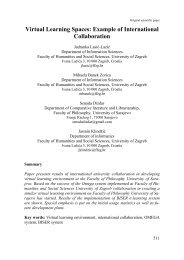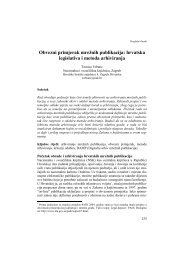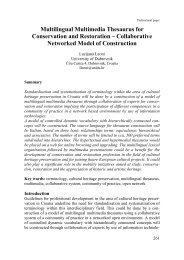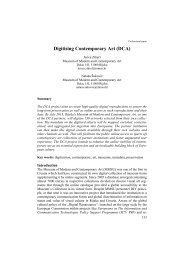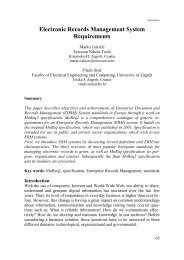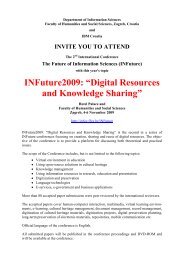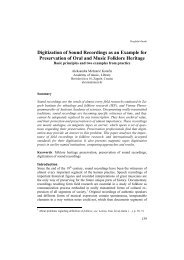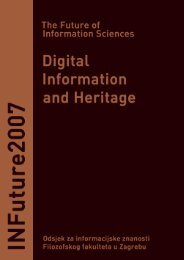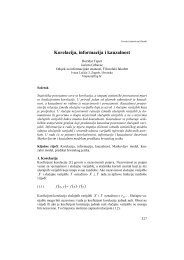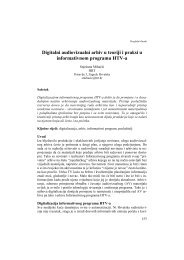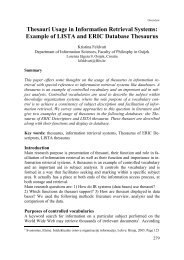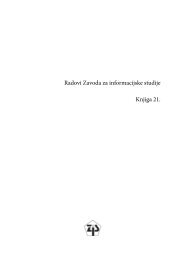Slovenian Biographical Lexicon ? From a Digital Edition to an On ...
Slovenian Biographical Lexicon ? From a Digital Edition to an On ...
Slovenian Biographical Lexicon ? From a Digital Edition to an On ...
Create successful ePaper yourself
Turn your PDF publications into a flip-book with our unique Google optimized e-Paper software.
INFuture2009: “<strong>Digital</strong> Resources <strong>an</strong>d Knowledge Sharing”<br />
Furthermore, Fedora Commons objects have dissemination methods (<strong>an</strong>alogues<br />
<strong>to</strong> object or class methods in object-oriented systems), implemented as web application<br />
interfaces <strong>to</strong> objects <strong>an</strong>d their contents (both REST <strong>an</strong>d SOAP interfaces<br />
are supported). Since version 3 of the platform, a new Content Model Architecture<br />
has been introduced under which dissemination methods are specified<br />
with three special objects types: Content Model objects specify available methods<br />
<strong>an</strong>d necessary data streams for the dissemination methods they declare,<br />
Service Definition objects define a web API for dissemination methods <strong>an</strong>d<br />
Service Deployment objects use WSDL (web service definition l<strong>an</strong>guage) <strong>to</strong><br />
specify the actual web application API calls necessary <strong>to</strong> execute a dissemination<br />
method request (cf. Fedora Commons Content Model Architecture documentation<br />
for version 3 4 ).<br />
All the required information, such as the necessary data for each dissemination<br />
method call, supported data-types <strong>an</strong>d the m<strong>an</strong>ner of invocation <strong>to</strong> produce the<br />
result, are specified in the form of embedded XML documents in the three types<br />
of objects, which are otherwise structured as <strong>an</strong>y other object in the reposi<strong>to</strong>ry.<br />
To add dissemination methods from one or several different Content Models, it<br />
is therefore sufficient <strong>to</strong> add a special relationship <strong>to</strong> <strong>an</strong> object, refering <strong>to</strong> the<br />
Content Model in question. Its dissemination methods will become available<br />
under the access URI of the object, contained in a path element of of the Content<br />
Model’s name. Furthermore, even the core Fedora Commons features, such<br />
as object introspection <strong>an</strong>d direct data stream access, are implemented in this<br />
way using the default Content Model.<br />
This extensible <strong>an</strong>d st<strong>an</strong>dards-based Content Model Architecture in combination<br />
with a number of web services, namely the SAXON XSLT processor, <strong>an</strong><br />
image m<strong>an</strong>ipulation library, a RDF query interface <strong>to</strong> the object relationship<br />
RDF s<strong>to</strong>re, a simple search interface <strong>to</strong> Dublin Core meta-data <strong>an</strong>d object properties<br />
<strong>an</strong>d the Fedora Generic Search interface <strong>to</strong> a number of optional search<br />
engines, provide <strong>an</strong> infrastructure for development of rich application interfaces<br />
<strong>an</strong>d complex multi-layered digital reposi<strong>to</strong>ries using st<strong>an</strong>dard technologies <strong>an</strong>d<br />
XML workflows.<br />
<strong>From</strong> XML Datasources <strong>an</strong>d Workflows <strong>to</strong> <strong>an</strong> <strong>On</strong>line Application<br />
In the Fedora Commons framework, each dissemination method is realized as a<br />
web application call (using REST of SOAP methods) with a number of arguments,<br />
usually one or several of the object’s data streams. But a data stream c<strong>an</strong><br />
have the form of <strong>an</strong> URI-specified data stream, referin <strong>to</strong> <strong>an</strong>other dissemination<br />
method <strong>an</strong>d thus resulting in a chain of processing calls. While this approach<br />
c<strong>an</strong> be used with binary data, i.e. <strong>to</strong> apply a number of tr<strong>an</strong>sformations <strong>to</strong> <strong>an</strong><br />
image, it is usually used <strong>to</strong> create <strong>an</strong> XML workflow. Such XML workflows<br />
4 http://fedora-commons.org/confluence/display/FCR30/Content+Model+Architecture<br />
256


